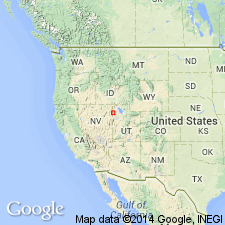
- Usage in publication:
-
- Clifside Limestone*
- Modifications:
-
- Named
- Biostratigraphic dating
- Dominant lithology:
-
- Limestone
- Siltstone
- AAPG geologic province:
-
- Great Basin province
Summary:
Named for exposures on crest and east slope of Toano Range, secs 3-4, T35N, R68E, Silver Zone Pass 7.5 min quad about 2 km north of Clifside railroad siding, Elko Co, NV in the Great Basin province, which is designated type section. Rocks in part formerly called "limestone of Clifside" (McCollum, McCollum, 1984; Glick, 1987). Present in Toano Range and northern Goshute Mountains. Distinguished by repetitious occurrence of light-gray oolitic grainstone interbedded with medium-gray wackestone (zebra-striped pattern), alternating with layers of moderate-brown siltstone with medium-gray wackestone interbeds (tiger-striped pattern). Ranges in thickness from 155-197 m at type to 205 m just south of Silver Zone Pass. Locally dolomitized near Silver Zone Pass pluton. At type divided into 3 informal members: lower limestone, middle silty limestone and shale, and upper limestone. Overlies Toano Limestone (new); underlies Morgan Pass Formation (new). Age is Middle Cambrian based on occurrence of BOLASPIDELLA which is also found in overlying and underlying units; thus Clifside is entirely within BOLASPIDELLA Assemblage Zone (late Middle Cambrian).
Source: GNU records (USGS DDS-6; Denver GNULEX).
For more information, please contact Nancy Stamm, Geologic Names Committee Secretary.
Asterisk (*) indicates published by U.S. Geological Survey authors.
"No current usage" (†) implies that a name has been abandoned or has fallen into disuse. Former usage and, if known, replacement name given in parentheses ( ).
Slash (/) indicates name conflicts with nomenclatural guidelines (CSN, 1933; ACSN, 1961, 1970; NACSN, 1983, 2005, 2021). May be explained within brackets ([ ]).

